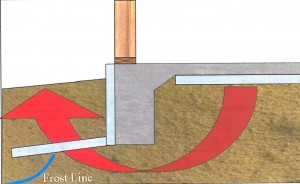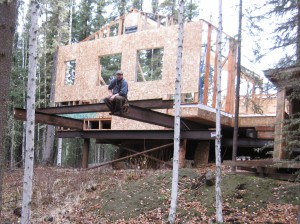
Photo Courtesy Wisdom & Associates. The frost protected shallow foundation uses insulation to create a heat bubble under the structure. The heat bubble keeps the ground underneath and around the structure from freezing, effectively raising the frost depth. The shallower frost depth allows for a shallower footer.
When building homes in cold climates, traditionally the foundation is placed on undisturbed (or compacted) soils and below the frost line to better resist the potentially destructive effects of ground freezing and frost heaving. In Alaska, every region has building codes and/or generally accepted design standards that specify the depth of the local frostline. In Fairbanks, the design depth for footings is a minimum of 42 inches below grade. Installing footings and a foundation wall at this depth can be expensive, and in some cases a shallow frost protected foundation (SFPF) might present a more economical option. As a general rule, a SFPF system is feasible only on ground free of permafrost.
Unlike a standard foundation, a shallow frost protected foundation can be placed well above the frost line — often at depths of about 16 inches below grade, and in some cases less. Since the foundation now rests on soils that normally would freeze seasonally, the key issue is to keep the ground underneath and on the sides of the foundation from freezing. SFPF designs usually depend on foam board insulation laid out far enough horizontally around the perimeter of the footing to ensure that the ground underneath remains thawed year round, no matter how cold it gets. In essence, the horizontal insulation creates a “heat bubble” in the ground under the building. A frost protected foundation can accommodate a variety of designs including thickened edge/monolithic slabs and shallow footings.
By code, the horizontal foam board insulation must be protected from sunlight and physical damage. Typically, this means the insulation will get covered with a layer of backfill thick enough to protect it for the life of the structure — although concrete or pavement coverings also might be options (in a high traffic area, for example). Typically, foundations including SFPF systems should extend a minimum of 6 inches above grade to keep wood framing away from ground moisture. Any vertical area above the horizontal insulation also must be well insulated.
In Interior Alaska, SFPF systems are fairly new and a professionally engineered design will buy a lot of peace of mind. Because of site-specific variations in soils conditions and foundation designs, a professional engineer will best be able to calculate the insulation values and installation methods to ensure the foundation will perform properly.
This model is included just to show how heat leaks from the foundation into the ground. “Warm” colors indicate temperatures above freezing. “Cool” colors indicate soil temperatures below freezing. The dashed blue line is the freezing front, which you do not want to contact the foundation.


